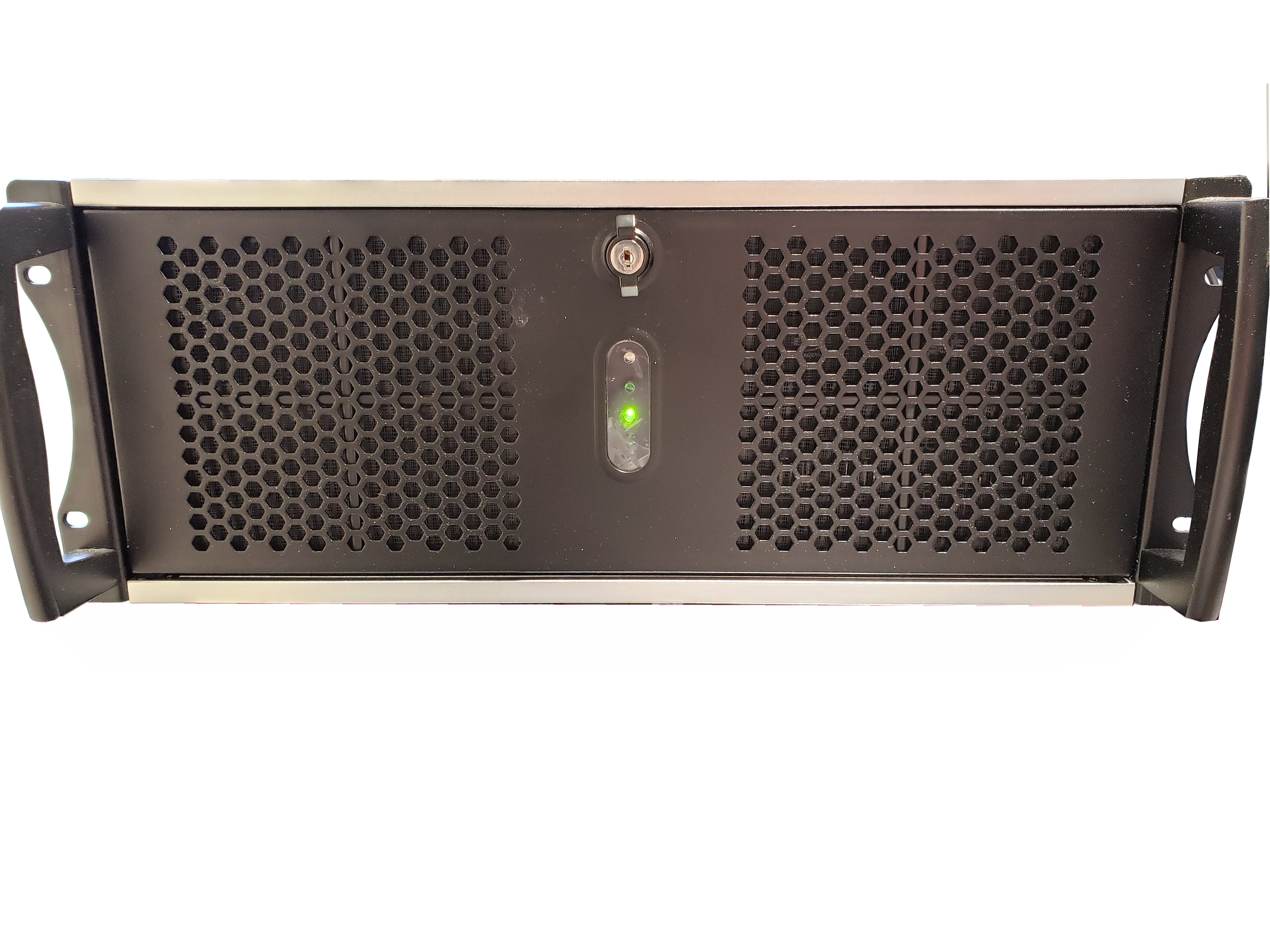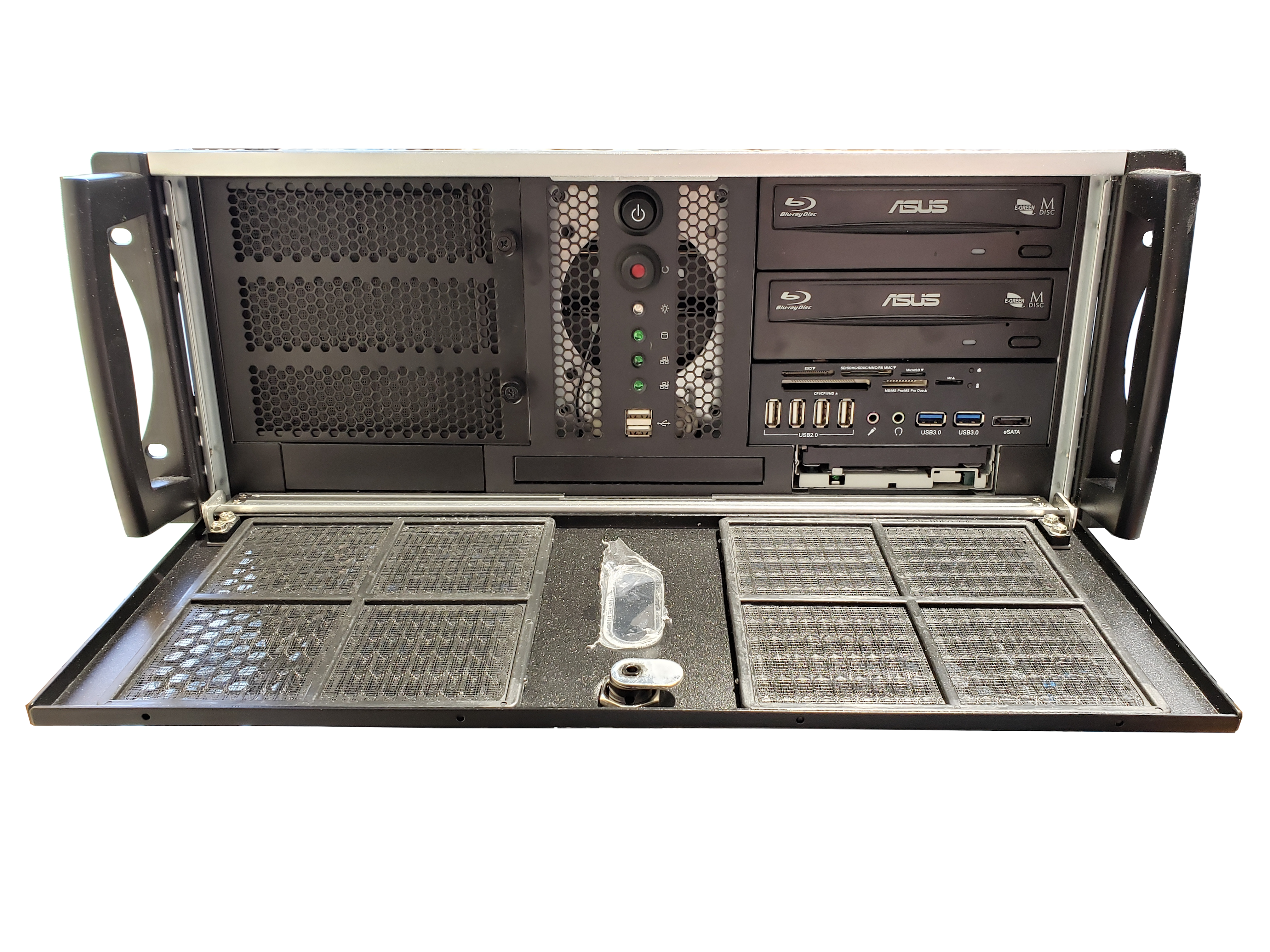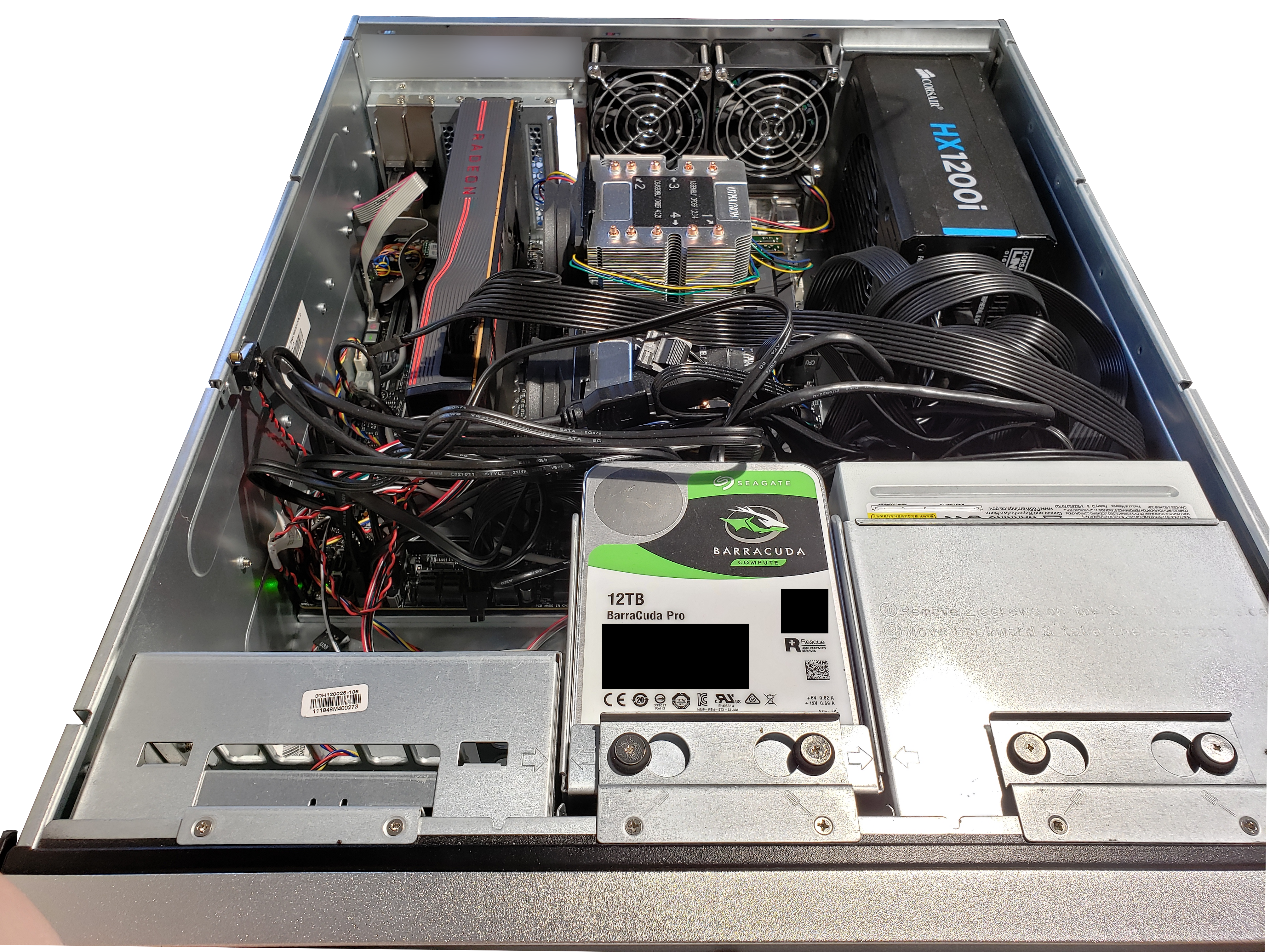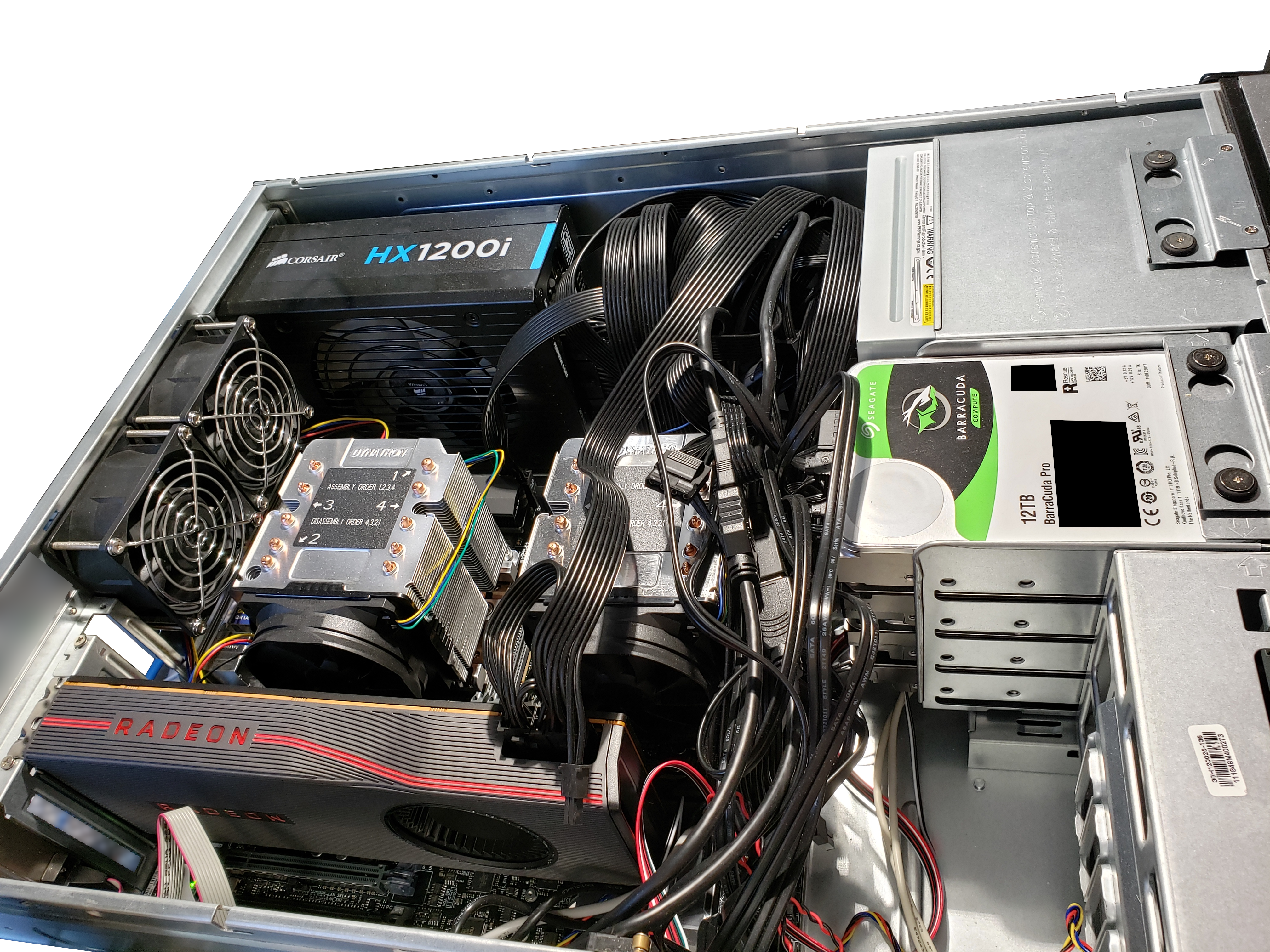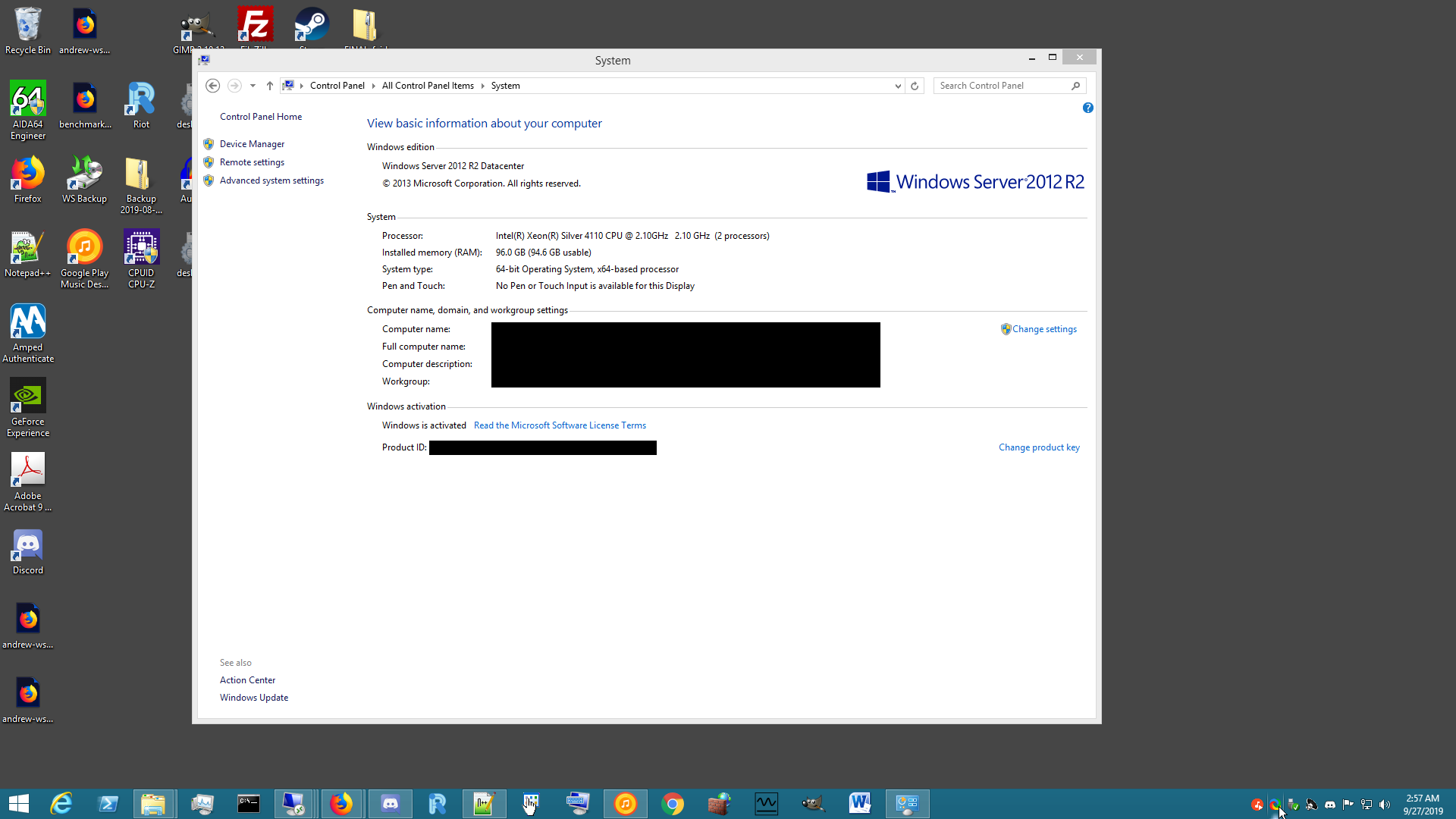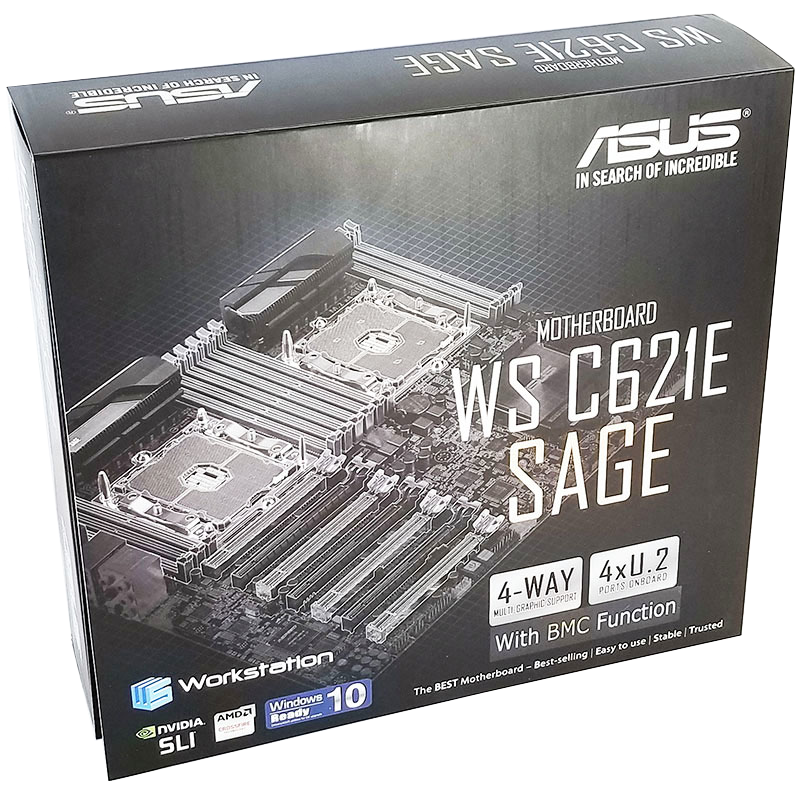Workstation A02
Built on August 25, 2019 Build Cost: $4,118.20 USD Total net cost of all system components, excluding sales tax, labor, and any applicable operating system and software licensing costs.

Overview
My first computer build, designed to my first custom-built daily-driver.
System Specifications
Detailed system specifications can be found below. In multi-boot configurations, the bolded item denotes the primary operating system. Additionally, items that appear greyed-out denote an original component or configuration that was either upgraded, replaced, or completely removed.
Operating System: | | [Triple-Boot Configuration]- Microsoft® Windows® 2012 R2 Datacenter $6,155.52 USD
- Microsoft® Windows® 10 Professional $199.99 USD
- Microsoft® Windows® Server 2016 Datacenter $6,160.00 USD
- Microsoft® Windows® Server 2019 Datacenter $6,160.00 USD
|
Processor: | | [Dual-Socket Configuration]- Intel® Xeon® Silver 4110 @ 2.10GHz, 8 cores, Socket P (LGA3647) $525.00 USD
- Intel® Xeon® Silver 4110 @ 2.10GHz, 8 cores, Socket P (LGA3647) $525.00 USD
|
Storage: | | [Multi-Disk Configuration]- 2TB Western Digital Enterprise 7.2K RPM SATA 3.5" HDD (Boot Drive) $44.99 USD
- 6TB Western Digital Enterprise 7.2K RPM SATA3 3.5" HDD (Data Drive A) $110.00 USD
- 6TB Toshiba 7.2K RPM SATA3 3.5" HDD (Data Drive B) $179.99 USD
- 12TB Seagate 7.2K RPM SATA3 3.5" HDD (Backup Drive) $439.98 USD
|
Optical Drive: | | 2x ASUS Blu-Ray/DVD Drive BW-16D1HT $149.98 USD |
Floppy Drive: | | Stock floppy drive taken from a restored Dell® Dimension 4600 from 2003. Aesthetic purposes only, not connected. |
Memory: | | 6x Crucial™ 16GB DDR4 DIMM @ 2666MHz (96GB total) $532.92 USD |
Video Card: | | AMD RX 5700XT, 8GB GDDR6 $399.99 USD |
Sound Card: | | Creative Sound Blaster Audigy PCIe RX 7.1 $69.99 USD |
Network: | | [Onboard] Gigabit LAN controller |
Wireless: | | N/A |
Motherboard: | | ASUS WS C621E SAGE $661.53 USD |
Power Supply Unit: | | CORSAIR® HX1200i $248.99 USD |
Case: | | Chenbro® Rackmount 4U Server Chassis RM41300-F1 $163.41 USD |
Additional Hardware: | | - 2x Dynatron B14 3U Active CPU Heatsink $79.64 USD
- 2x GDSTIME 80mm x 38mm 8038 PWM High Speed Dual Ball Bearing DC 12V 80mm Cooling Fan $31.98 USD
- EZDIY-FAB 2-Port USB 3.0 USB 2.0 HUB Power ESATA HD Audio All in-1 5.25" inch Metal Optical Drive Bay Front Panel Card Reader with 20pin Adapter $29.99 USD
- Kingwin 2 Port USB 3.0 Splitter Adapter USB Type A Female to 20 Pin Motherboard Header Extension Cable $4.49 USD
|
Media
Click on each image or video to view full-size. Links will open in a new tab or window, depending on your browser.
Details
This system was my first build of all time. Since it was my first build and I didn't want to blow anything up, one of my good friends (a seasoned PC builder) accompanied me through the actual physical build process of the system via Google Hangouts. I wanted to take advantage of the "custom build" idea further than the average person and essentially build a powerful workstation. The first idea that came to my mind for such a thing was a dual-socket system, so that is where I began my adventure— finding a quality, dual-socket motherboard.
I finally settled on the ASUS WS C621E SAGE motherboard— it boasted dual LGA3647 sockets, in addition to some other very interesting features, such as IPMI. Since I was obviously looking to build a dual-socket system, it was unfortunate that a typical consumer-grade processor from Intel was not an option, as the consumer processors (such as the Intel® i3/i5/i7/i9/etc series) did not support a multi-processor setup. This time around, I was indeed looking to stick to an Intel CPU, so the Xeon is where I began looking as they are where you must go to find models that support multi-processor configurations as far as Intel hardware is concerned. Since I was on a budget and would "need"— in order to actually build the dual-socket system— to buy two of the same processors, I had to be careful and choose a processor wisely as I would effectively need to pay twice the price for two units. After much research, I chose to settle with the Xeon Silver 4110. At $525 per processor, I ordered a pair for a total of $1,141.88 after taxes.
Unfortunately, there was some saga with the purchase of the motherboard and I waited over a month for the motherboard to arrive, only to find that the seller I ordered it from was none other than a scammer. I got my money back and ordered from someone else— finally, the board arrived about a week and a half later.
This build proved to be more of a challenge than I expected. The initial build attempt started out fairly smooth and straightforward. First, the system memory was installed while the motherboard was outside of the case. Afterwards, the motherboard was placed into the case, atop several existing standoffs, which thankfully already aligned with the motherboard. After securing the motherboard into the case, I began installation of both processors. It was during this point that the build was brought to a screeching halt when I discovered the CPU heatsinks that I had seemingly did not fit the socket, despite being advertised that they would fit. Some more thorough research seemed to suggest that there were two "form-factors" for this socket: square ILM and narrow ILM. Indeed, I had a narrow ILM heatsink that would not fit into a square ILM socket. The heatsinks were returned and another pair ordered.
After receiving the new heatsinks a week after, the second build attempt began. Finally, the heatsinks did fit onto the motherboard, but the retention screws required a torque screwdriver which proved extremely difficult to find. As if that wasn't complicated enough, several screw holes were very small and ran down the height of the entire cooler, requiring an unusually long and extremely thin torque screwdriver, which increased the difficulty of securing the heatsinks by several magnitudes. I worried greatly about being unable to finish the build due to just these difficulties alone, but luckily I made it, and moved on.
I then continued the build by installing the two optical drives (ASUS Blu-Ray/DVD Drive BW-16D1HT), the 5.25" multi-function card reader and USB port extension bay (EZDIY-FAB 2-Port USB 3.0 USB 2.0 HUB Power ESATA HD Audio All in-1 5.25" inch Metal Optical Drive Bay Front Panel Card Reader with 20pin Adapter), the four internal hard-drives, and the video card (an AMD RX 5700XT).
It was then time for the second-to-last step: installing the power supply (a CORSAIR HX1200i, 1200 Watt, 80+ Platinum Certified, Fully Modular PSU) and installing all the necessary power connections.
Unfortunately, even with the full modularity of the power supply, the wire management was (and still is) absolutely atrocious. The hard-drive SATA connectors had barely any room, and were already pushing against the adjacent processor heatsink. I was too excited at this point to care however, so I left it as-is so I could find out if it would even power on for the first time.
Finally the time had come: time to press the power button and see if the system either powered on or would begin emitting smoke. Success! The system powered on and completed POST without issues. My friend and I smiled in awe and happiness at the almighty and holy BIOS as it came up on-screen.
It was late (about 2am/02:00) so my friend headed off to bed after congratulating me on my first successful system build. I attempted to install Windows Server 2008 R2 onto the system, but after many attempts, was sadly unable to get the system to boot under EFI/UEFI mode with this particular chipset. At this point, I had no choice but to ditch my original plan to include Windows Server 2008R2 in a hexaboot setup and instead, proceeded to install Windows Server 2012 R2, which went smoothly without any issues.
Upon installation of the operating system, I began my usual course of installing drivers: chipset, network, and graphics drivers in that particular order. Graphics drivers proved impossible to install for some reason or another, as for reasons unknown, the AMD drivers were not able to detect their own hardware. Even my manual attempt to install the drivers failed, as there was no driver for the AMD RX 5700XT (or any RX 5700 for that matter). This essentially half-prevented me from being able to use the OS for anything serious, due to having no drivers for the video card, and no integrated graphics (only select Xeons support integrated graphics and this pair was not among the ones that did).
Finally, on the 29th of August 2019, AMD released a non-WHQL driver update, which did in-fact include a driver for several RX 5700 video cards. Automatic installation STILL did not work, but I was able to manually extract the drivers and install them myself.
Initial gaming tests in Windows Server 2012 R2 proved to be fairly stable, but I only tested one game, so it was not exactly fair to be completely conclusive. Over the next few days, I had installed Windows 10, Windows Server 2016, and Windows Server 2019 on to separate partitions for a penta-boot setup, which would later be completed after installation of Ubuntu Linux.
Windows 10 and Windows Server 2016 both proved to be a major disaster, even in this day and age, with constant blue screens of death (BSOD)("crashes"). I was particularly angry with Windows 10 as it continued to update, reboot, crash, reboot, update, ... (and repeat the cycle forever, despite me explicitly instructing it not to do so). Thus, the next day I erased it from the drive and installed Windows Server 2016 again without any updates, and only bare-bone drivers. Today, the "almighty and holy" Windows Server 2016 installation continues its legacy to be wholly unstable, just like its consumer counterpart. And Windows Server 2019 doesn't do all that much better either.
Ubuntu Linux is still scheduled to be installed onto this system in the near future. I am simply waiting and hoping that all the kinks in the Windows installations could be ironed-out first, so that Linux could be installed last in order to cleanly slip grub into the bootloader. To be continued...



